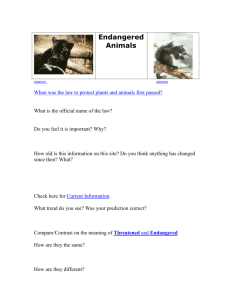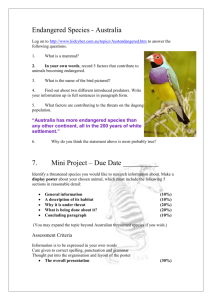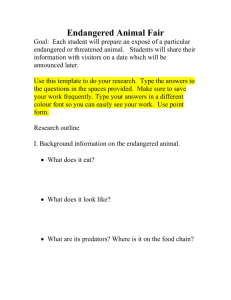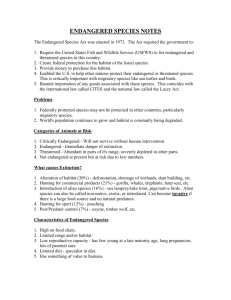Law Review_ Concept Review
advertisement
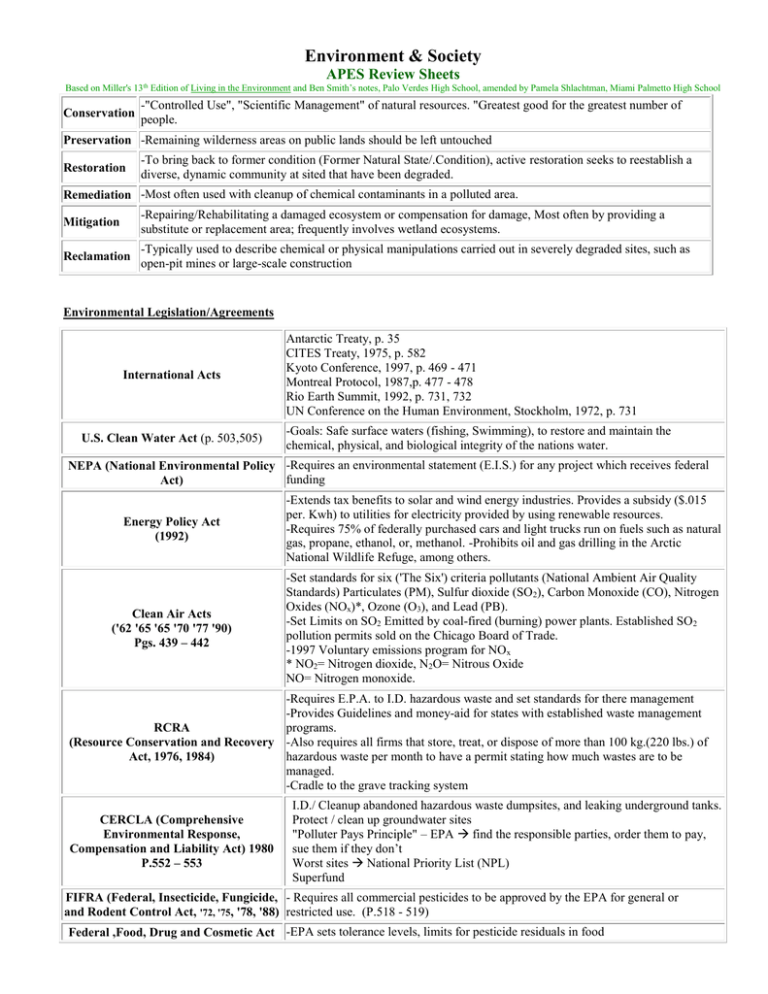
Environment & Society
APES Review Sheets
Based on Miller's 13th Edition of Living in the Environment and Ben Smith’s notes, Palo Verdes High School, amended by Pamela Shlachtman, Miami Palmetto High School
Conservation
-"Controlled Use", "Scientific Management" of natural resources. "Greatest good for the greatest number of
people.
Preservation -Remaining wilderness areas on public lands should be left untouched
Restoration
-To bring back to former condition (Former Natural State/.Condition), active restoration seeks to reestablish a
diverse, dynamic community at sited that have been degraded.
Remediation -Most often used with cleanup of chemical contaminants in a polluted area.
Mitigation
-Repairing/Rehabilitating a damaged ecosystem or compensation for damage, Most often by providing a
substitute or replacement area; frequently involves wetland ecosystems.
Reclamation
-Typically used to describe chemical or physical manipulations carried out in severely degraded sites, such as
open-pit mines or large-scale construction
Environmental Legislation/Agreements
International Acts
U.S. Clean Water Act (p. 503,505)
Antarctic Treaty, p. 35
CITES Treaty, 1975, p. 582
Kyoto Conference, 1997, p. 469 - 471
Montreal Protocol, 1987,p. 477 - 478
Rio Earth Summit, 1992, p. 731, 732
UN Conference on the Human Environment, Stockholm, 1972, p. 731
-Goals: Safe surface waters (fishing, Swimming), to restore and maintain the
chemical, physical, and biological integrity of the nations water.
NEPA (National Environmental Policy -Requires an environmental statement (E.I.S.) for any project which receives federal
funding
Act)
Energy Policy Act
(1992)
-Extends tax benefits to solar and wind energy industries. Provides a subsidy ($.015
per. Kwh) to utilities for electricity provided by using renewable resources.
-Requires 75% of federally purchased cars and light trucks run on fuels such as natural
gas, propane, ethanol, or, methanol. -Prohibits oil and gas drilling in the Arctic
National Wildlife Refuge, among others.
Clean Air Acts
('62 '65 '65 '70 '77 '90)
Pgs. 439 – 442
-Set standards for six ('The Six') criteria pollutants (National Ambient Air Quality
Standards) Particulates (PM), Sulfur dioxide (SO2), Carbon Monoxide (CO), Nitrogen
Oxides (NOx)*, Ozone (O3), and Lead (PB).
-Set Limits on SO2 Emitted by coal-fired (burning) power plants. Established SO2
pollution permits sold on the Chicago Board of Trade.
-1997 Voluntary emissions program for NOx
* NO2= Nitrogen dioxide, N2O= Nitrous Oxide
NO= Nitrogen monoxide.
-Requires E.P.A. to I.D. hazardous waste and set standards for there management
-Provides Guidelines and money-aid for states with established waste management
programs.
RCRA
(Resource Conservation and Recovery -Also requires all firms that store, treat, or dispose of more than 100 kg.(220 lbs.) of
hazardous waste per month to have a permit stating how much wastes are to be
Act, 1976, 1984)
managed.
-Cradle to the grave tracking system
CERCLA (Comprehensive
Environmental Response,
Compensation and Liability Act) 1980
P.552 – 553
I.D./ Cleanup abandoned hazardous waste dumpsites, and leaking underground tanks.
Protect / clean up groundwater sites
"Polluter Pays Principle" – EPA find the responsible parties, order them to pay,
sue them if they don’t
Worst sites National Priority List (NPL)
Superfund
FIFRA (Federal, Insecticide, Fungicide, - Requires all commercial pesticides to be approved by the EPA for general or
and Rodent Control Act, '72, '75, '78, '88) restricted use. (P.518 - 519)
Federal ,Food, Drug and Cosmetic Act -EPA sets tolerance levels, limits for pesticide residuals in food
-1958 – Delaney Clause zero tolerance
1996 Amendments acceptable risk one in a million level
risks vs. benefits
extra protection for children
-Prohibits transportation of live or dead animals or their parts across state boarders
without a federal permit. P. 582
Lacey Act (1900)
National Federal Wildlife Refuge
System (1903) p.586
Migratory Bird Hunting Stamp Act
(1934)
-
-Required waterfowl hunters to buy a federal duck-hunting license.
-Sale of these permits goes to waterfowl research and purchasing of land for waterfowl
refuges.
Q.-What type :Economic Solution/Approach" is this?
p.590
-
Endangered Species Act
(1973, '82, '85, '88)
-
Taylor Grazing Act (1943)
Established by Teddy Roosevelt
First refuge – Pelican Island in FL
¾ of the refuges are wetlands protecting migratory waterfowl
20% of US threatened/ endangered species have habitats in this system
Authorizes the (NMFS) National Marine Fisheries Service to I.D. and list
endangered and threatened species.
- Authorizes the Fish and Wildlife Services (USFWS) to I.D. out list
endangered/threatened species that are not under the authority of the NMFS.
- These species cannot be hinted, killed, collected, or injured in the U.S.
(Over 1,000 animals on the list, with approx. 700 animals outside of the U.S.)
Designate and protect critical habitat
Habitat Conservation Plans – landowners, developers, loggers are allowed to
destroy some habitat and/or some endangered or threatened species in
exchange for taking steps to that species
Pages 583 - 586
-Permit required and fees for use of federal grazing lands.
-Limits on number of livestock that could be grazed.
-To preserve large expanses of pristine lands
p. 627 – 628.
Wilderness Act (1964)
Wild and Scenic Rivers Act (1968)
Surface Mining Control and
Reclamation Act (1977)
-Preservation of and no development of certain rivers.
-Requires reclamation of lands mined
Tax on mining companies to restore land damaged prior to the law being passed
p. 343
Additional laws / initiatives Clear Skies Initiative and Healthy Forest Act
Species Related Terms and Concepts
Know the "Parts of", "Dynamics and Processes of ", "Significance/Meaning of", AND be able to explain/discuss each of the
following:
Types (Define these
terms)
Examples (know why)
Endangered/Threatened
Giant Panda, Florida Manatee, Presido Manzanita, Black-footed ferret, Kangaroo Rat, Florida
Panther, Sand Verbena, Bladder Pod, Torreya, Monk Seal, Northern Spotted Owl, Red Wolf,
Wyoming Toad, Gopher Tortoise, Black Rhino, California Condor, Boulder Darter Scrub Mint,
American Burying Beetle, Piping Plover, Florida Key Deer, Grizzly Bear, Chinook Salmon,
Arizona Agave, Oahu Tree Snail, Greenback Cutthroat Trout, Hawksbill Sea Turtle, Wood Stork,
Ocelot, American Crocodile, Green Pitcher Plant, black rhinoceros
Low reproduction rate, Specialized feeding habits, Feed at high trophic levels, Large size,
Characteristics of
Limited or specialized nesting or breeding areas, Found in only one place or region, Fixed
Extinction-Prone Species migratory patterns, Preys on livestock or people, Behavior patterns
Keystone
Indicator
Alligator, Wolf, Prairie Dog, Fig Trees, Plankton, Kelp/Sea Otters, Mycorrhizae Fungi.
Most Songbirds (e.g. Warblers), Amphibians (Frogs, Salamanders), Lichens, Aquatic macro
invertebrates (Aquatic macro invertebrates differ in their sensitivity to water pollution)
Introduced/Non-Native
Kudzu, Water Hyacinth, Purple Loosestrife, Rabbits in Australia, Argentine Fire Ants, European
wild Boar. Dutch Elm Disease (Fungus), Zebra Mussel, Quagga Mussel, Melaleuca, Brazilian
Pepper, Bufo marinas (cane toads).
Pests
Gypsy Moth, European Red Mite, Boll Weevil, tobacco Horn worm, Grasshopper (Locust), Pink
Bullworm, Brown Plant hoppers, Aphids, Screwworm flies, cottony cushion scale, Anopheles
mosquito, caterpillars
Biological Control of
Pest Species
Interactions
r- or K-strategist
Wasps, Beetles (Lady Beetles, Lady Bugs), Vedalia Beetle Larva, Praying mantises, Bacillius
thuringiensis.
Interspecific Competition, Predation, Parasitism, Mutualism, Commensalism, Interference
Competition, Exploitation Competition, Competitive Exclusion, Resource Partitioning, Realized
Niche, Fundamental Niche, Predator-Prey Relationship (in food chain or web arrows go from the
source to the eater)
r
many small offspring, little or no parental care or
protection of offspring, early reproductive age,
most offspring die, small adults, adapted to
unstable climate, high population growth rate,
population size fluctuates wildly above and below ,
generalist niche, low ability to compete, early
successional species
K
fewer, larger offspring, high parental care,
later reproductive age, most offspring
survive, larger adults, adapted to stable
climate, lower population growth rate,
population fairly stable, specialist niche,
high ability to compete, late successional
species
